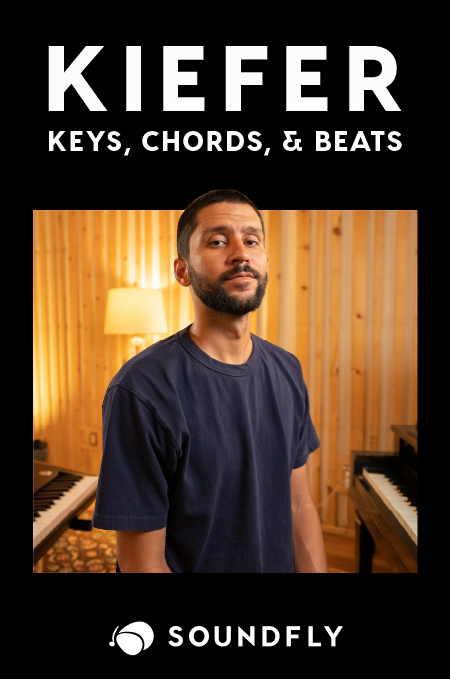
+ Improve your songwriting with Soundfly! Explore our range of courses on emotional chord progressions, basic songwriting technique, songwriting for producers, and many more. Subscribe for unlimited access here.
By Hannah Sumner
I had finally reached a point in my career where I was recording at least five sessions a week, teaching regularly, and performing several times a week. For a vocalist in NYC I felt like I was on my way. Only problem was that after two to three sessions, I noticed that my voice felt raw and tired. I had to rest for a day, which meant I lost work or had to extend deadlines. But I knew that there must be a way to sing powerfully without tiring. I mean, look at Beyoncé or Ariana Grande. There had to be a way! So, I asked around to my fellow vocalists, and was recommended a teacher who changed my life.
The first thing they helped me discover is that singing properly is all about using your instrument efficiently. You do not need to push or scream to reach your high notes. This will definitely strain your voice.
I know we as singers often think that if we are going to give it our all emotionally, it means we have to be just as intense with our belt. But I am here to tell you there is a way to achieve this benefit without damaging your vocal chords. It just takes a bit of focused practice.
Preparation, Onset, Release
Ah, the magical three that has come to rule my life.
Alright, first let’s work on our preparation for singing. I want you to put your hand on your stomach right around where your belly button is. Now I want you to breath in through your mouth, and I want you to inflate your low belly. It should rise just like you’re filling a balloon with air. Now I want you to hiss out the air through your teeth. This should take you 40-60 seconds.
Great! When you’re finished, I want you to take this same breath with your hand on your stomach, or diaphragm as some may know, and I want you to pay attention to the movement that happens when you begin your hiss. There is a tiny compression of the diaphragm that happens, and this is called your “tuck.” The tuck is the onset. This movement is what compressed the air in your lungs so that now your vocal chords are supported.
When you sing, you want to push and hold tension in your diaphragm, not in your throat. I am sure you have seen singers with veins popping out of their neck, and that is not a good sign. Too much air pressure can blow out your vocal chords.
+ Learn songwriting, theory, production, composition, arranging, mixing, and more — whenever you want and wherever you are. Subscribe for unlimited access!
Practice Singing Vowels
Now, for the release of the note I want you to look at your reflection, open your mouth, drop your jaw, and say “ah.” This is the golden shape. “Ah” creates the most anatomically conducive shape and space for our chord structure, and no matter what vowel we’re singing, we’re always trying to create that same sense of space. When you sing high notes, your vocal chords stretch vertically and vibrate quickly. When you sing lower notes, they vibrate slower and are more open.
Because of these mechanics, you should never be applying mass amounts of pressure to your high notes. Instead, I think of it more as sliding the air up my vocal chords and executing it at the opening of my mouth.
Practice your preparation, onset, and release using “ah” at a variety of pitches, paying close attention to that feeling of openness, and work towards bringing that feeling into your body no matter what you’re singing.
Another great vowel to use is an “ou,” because this shape doesn’t allow you to spread the air, which can disrupt your technique. When you sing an “ou,” you have to get the air focused right at the front of your mouth. This is where we want the focus of all our notes and vowels.
Ask for Help
I know that reading this may seem a little confusing, which is why I urge singers, especially professional singers who may not think they need vocal training, to do some research and find a vocal coach. Even an amazing singer needs the help of a coach to reach the all-star level. Think about a high school baseball player. They are being scouted for college and pro and are throwing 75-80 mph, which is amazing, but in order to throw 90-92 mph in the pro level, game after game, without throwing your shoulder out, it takes study and precision that only a top-level coach can teach. Even if you can’t find someone on that caliber in your area, almost all coaches give Skype lessons these days.
Just remember your voice should never hurt after singing, and if it does then you are doing something wrong. Something that over time will be damaging. Keep practicing your technique, focus on applying that technique to your regular material, and start looking for a coach who can help get you to the next level. With the right support, I know you can achieve your singing dreams.
Get 1:1 coaching on your songwriting from a seasoned pro.
Soundfly’s community of mentors can help you set the right goals, pave the right path toward success, and stick to schedules and routines that you develop together, so you improve every step of the way. Tell us what you’re working on, and we’ll find the right mentor for you!
—
 Hannah Sumner’s music is stubbornly beautiful. Impressive in its graceful gathering of folk, minimalism, and pop, these drum-based tracks ferociously blast the soul’s inner blues while providing uplift in their very passion.
Hannah Sumner’s music is stubbornly beautiful. Impressive in its graceful gathering of folk, minimalism, and pop, these drum-based tracks ferociously blast the soul’s inner blues while providing uplift in their very passion.




